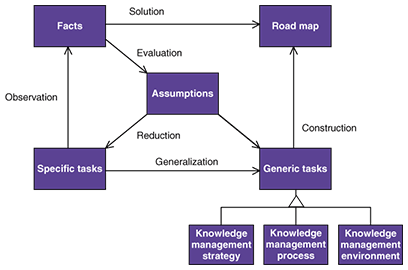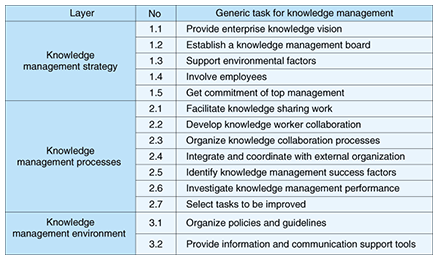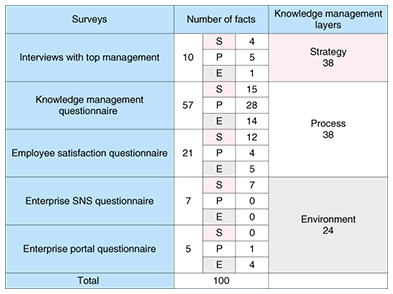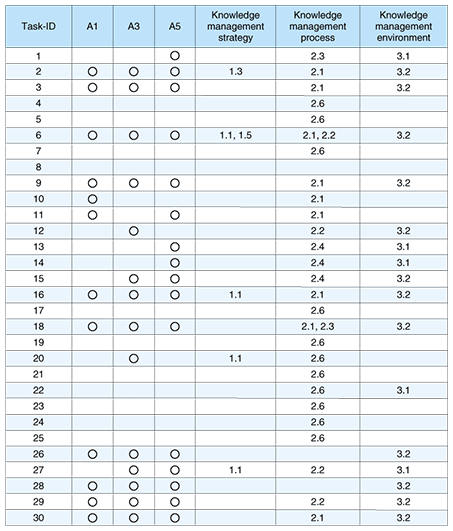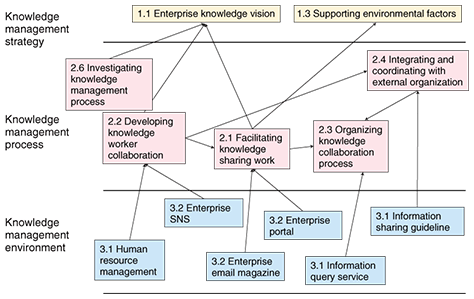 |
|||||||
|
|
|||||||
|
Special Feature: Knowledge Creation Design Methodology for Service Innovation Vol. 6, No. 7, pp. 25–32, July 2008. https://doi.org/10.53829/ntr200807sf5 Design Method for a Knowledge Sharing NetworkAbstractWe describe a method of designing an architecture for sharing enterprise knowledge. Knowledge-creating companies are becoming attractive as the service sector of the economy grows. Although knowledge management methods have been applied, they are insufficient for sharing and integrating knowledge among different divisions of a company. Our method evaluates knowledge management assumptions based on facts and then extracts the important tasks for implementing those assumptions in a hierarchical knowledge sharing architecture. The hierarchical knowledge sharing architecture consists of the business vision, knowledge process, and knowledge sharing environment. Finally, our method helps in the design of a hierarchical road map of tasks for enterprise knowledge sharing.
1. IntroductionThe business guru Peter F. Drucker told us that the basic resource of the economy is knowledge [1]. In the last few years, companies have been putting more emphasis on this trend, and knowledge management has become recognized in our society again. Many corporate managers want to make their companies into knowledge-creating companies. Knowledge utilization in business management is not mere management of the knowledge stored in a company. Many companies try to make knowledge sharing networks among employees, members of the company's management board, and the company's customers and business partners. We think that it is important to design the process of a knowledge sharing network in keeping with the company's business management policy. In this article, we describe a knowledge management design method for promoting knowledge sharing networks in and around a company. Our method evaluates knowledge management assumptions based on the facts and then extracts the important tasks for implementing the assumptions in a hierarchical knowledge sharing architecture, which consists of the business vision, knowledge process, and knowledge sharing environment. Finally, it helps in the design of a hierarchical road map of the tasks for making a network for sharing the knowledge of an enterprise. 2. Enterprise knowledge management architecture design methodOur method of designing the process of the enterprise knowledge sharing architecture has five steps. Step 1: Develop knowledge management assumptions. The assumptions will be used to prioritize the knowledge management tasks on the basis of observations of the effectiveness of these tasks. Step 2: Survey the effectiveness of knowledge management tasks using questionnaires and interviews. Step 3: Evaluate knowledge management assumptions using evidence derived from the facts gathered by the above surveys. Step 4: Select the knowledge management tasks that have low scores in the evaluation. In this step, we use a knowledge management architecture that has three layers, i.e., knowledge management strategy layer, knowledge management process layer, and environment layer. The knowledge management environment layer includes business rules and information technology (IT) tools that support knowledge management processes. Step 5: Develop a knowledge management road map based on the previously extracted tasks. In this step, knowledge management tasks are interrelated in the three-layer architecture. For large companies, we may have many knowledge management tasks and corresponding observation facts. In these large knowledge management cases, we should have a method of reducing the numbers of facts and tasks in order to promote knowledge management. To do this, we develop assumptions for describing the knowledge management architecture to be made. The assumptions are then evaluated and assigned weights calculated from related facts. If an assumption “a” is related to fact “f”, its weight W (a, f) is defined as follows. W (a, f) = 2 if “a” is supported by “f” The total weight TW of assumption “a” is defined as TW (a) = ΣW (a, f), where “f” is a fact. We also define W (a, L) as ΣW (a, f), where “f” is a fact of knowledge management layer L. As we have three knowledge management layers, the following expression holds. TW (a) = W (a, strategy) + W (a, process) + W (a, environment) We can now decide the order of assumptions from the value of TW (a). A threshold value V is used to extract the weak assumption WA = {a| TW (a) <V}. Then, we can extract candidate generic tasks based on the relationship between assumptions and specific tasks. The specific tasks ST are defined as ST (a) = {t| an assumption “a” is supported by task “t”}. The weighted specific task WST is defined as WST = {t| for an “a” in WA, “a” is supported by task “t”}. The generic task GT is defined as GT (a) = {g| “g” is the generic task for a specific task of ST (a)}. The candidate generic task CGT is defined as CGT = {g | “g” is an element of GT (a), where “a” is an element of WA}. The weighted generic task WGT is defined as WGT = {g | “g” is a generic task for a specific task of WST}. Obviously, WGT =CGT. The road map will be developed using the generic tasks defined by CGT to solve the problems elicited by the facts. The relationships among the above knowledge management design constituents are shown in Fig. 1. The current specific knowledge management tasks are observed and facts about these tasks are gathered in survey reports. The assumptions are developed to extract insufficiently supported tasks by evaluating facts, as described above. After specific tasks to be improved have been selected, they are transformed into generic tasks for describing a knowledge management road map. The transformed generic tasks are categorized hierarchically into strategic, process, and environment levels. To develop this hierarchy, we can use generic task patterns such as the knowledge networks proposed by Enkel et al. [2]. Hierarchical generic tasks based on these knowledge networks are shown in Table 1.
(1) Knowledge management strategy layer In this layer, the following strategic tasks are defined. Enterprise knowledge vision provides knowledge management goals and a road map for achieving them. The road map provides the interrelationships among knowledge management tasks. The involvement of employees and the commitment of top management are necessary for the success of enterprise knowledge management. Establishing a knowledge management board is also important for successful knowledge management. The board manages the total enterprise knowledge management program. Environmental factors of knowledge management should also be supported by the board and top management if necessary. (2) Knowledge management process layer This layer has two kinds of knowledge management processes. The first type is knowledge sharing work. Facilitating knowledge sharing work helps individual employees share knowledge. Developing knowledge worker collaboration helps employees break through the barriers existing between different organizations. Organizing knowledge collaboration processes changes the legacy working style to enable effective knowledge sharing. Integrating and coordinating with external organizations enables the development of knowledge sharing networks with other organizations. Processes of the second type are necessary to maintain enterprise knowledge management processes. These processes include identifying knowledge management success factors, investigating knowledge management performance, and selecting knowledge management tasks that require improvement. These processes are used for designing the enterprise knowledge management architecture. (3) Knowledge management environment layer This layer includes two things for knowledge management: (i) organizing policies and guidelines and (ii) providing information and communication support tools. Using this table showing candidates for knowledge management generic tasks, we can easily describe the knowledge management road map at an appropriate level. 3. ExampleIn this section, we explain the process of designing an enterprise knowledge management road map using our method. 3.1 Target knowledge management activitiesA certain enterprise had 30 knowledge management tasks. Its IT management division wanted to evaluate and integrate current activities. They had also tried to develop a road map based on the new vision of knowledge management, but because they already had a large number of different current knowledge management activities, this development was difficult. Furthermore, they had received five survey reports, as shown in Table 2. These reports included 100 facts about the current knowledge management activities. The top management interviews had 10 facts related to knowledge management strategy. The knowledge management and employee satisfaction questionnaires had 78 facts about knowledge management processes. The enterprise social networking service (SNS) and enterprise portal questionnaires had 12 facts about knowledge management environment tools.
These facts were useful for evaluating the effectiveness of the current knowledge management activities as well as extracting problems with the current knowledge management status. 3.2 Knowledge management assumptionsIn the first step of our method, we develop the knowledge management assumptions. The assumptions are useful for verifying the effectiveness of the current activities. We made the following five assumptions in this case study for the evaluation. A1: The intranet information can be completely used. A2: The level of information sharing can be managed flexibly. A3: The relationship between knowledge users and content can be managed. A4: Specialists perform mutual collaboration. A5: From the viewpoint of the user, knowledge management tasks are well integrated. The intention of A1 is that business goals are solved by effective use of intranet information. A2 describes that an appropriate knowledge expression is necessary for different knowledge. For example, the method of sharing explicit knowledge about documents is different from those of sharing tacit knowledge. A3 says that the knowledge classification should be suitable for business processes. A4 shows that promotion of a corporate culture in which employees collaborate with each other is effective. A5 says that integration and usability of knowledge management activities are effective for business management. It is necessary to develop a knowledge management vision and road map to realize the vision. These assumptions are useful for developing the knowledge management vision. 3.3 Evaluation of knowledge management tasks(1) Gathering facts for evaluating knowledge management assumptions In the case study, we had 5 surveys and 100 facts, as shown in Table 2 and Section 3.1. The table also shows the relationship between the surveys and knowledge management layers. There were 38, 38, and 24 facts for the strategy, process, and environmental layers, respectively. The top management interviews included 4, 5, and 1 facts for the three layers, respectively. Because the enterprise SNS had just been introduced, the SNS questionnaire included only the facts about the strategy layer. On the other hand, the enterprise portal questionnaire did not include any strategy-layer facts because the portal has a long history for enterprise knowledge management in the company. (2) Evaluating the assumptions The results of evaluating the assumptions by utilizing the facts are shown in Table 3. The assumptions were A1, A2, A3, A4, and A5. When we set threshold V = -10, we got WA = {A1, A3, A5}. Assumptions A1, A3, and A5 need to be improved.
The table also shows that the knowledge management process layer has many problems because the total score of the layer was the worst one. Many enterprises have the same problem with legacy knowledge management programs. The problem is as follows. Although many knowledge management services have been introduced, not all companies are satisfied and the systematic effectiveness is unsatisfactory because there is no collaboration process. 3.4 Selection of knowledge management tasks to be improvedOn the left hand side, Table 4 shows the relationship between 30 tasks and selected assumptions A1, A3, and A5. On the right hand side, it also shows the relationship between 30 tasks and the generic knowledge management tasks in Table 2.
First, ST (A1), ST (A3), and ST (A5) were extracted and then merged. In this way, we obtained the following task set WST to be improved. WST = {1, 2, 3, 6, 9, 10, 11, 12, 13, 14, 15, 16, 18, 20, 26, 27, 28, 29, 30}} In this case, our reduction efforts eliminated 11 out of the 30 tasks. We then got the following generic task set WGT by using the right hand side of the table. WGT = {1.1, 1.3, 2.1, 2.2, 2.3, 2.4, 2.6, 3.1, 3.2} Now we are ready to develop the road map for the enterprise knowledge management. The WGT will be the basis of the road map. 3.5 Development of knowledge management road mapThe developed road map is shown in Fig. 2. The strategy layer has enterprise vision and supporting factors. The knowledge process layer has four generic tasks: facilitating knowledge work, promoting knowledge worker collaboration, organizing knowledge collaboration, and collaborating with the external organization. In this layer, we also add knowledge management process #2.6, although we have only one task (task 20) for the facts from the survey reports. The investigation of the knowledge management process was conducted through interviews and currently is not supported by tools in the knowledge environment layer. The results were used for the enterprise knowledge vision. Other knowledge management tasks, #2.5 and 2.7, could be added to the road map for completeness.
The knowledge environment layer contains specific tasks because the generic task is too broad for understanding the objective tasks. We chose these tasks from WST. Extracted organizational rules are human resource management, information sharing guidelines, and collaborative work style. Information and communication tools are enterprise SNS, enterprise email magazine, and enterprise portal services. In this way, it is easy to make the enterprise knowledge management steps. The relationship between tasks indicates the necessary condition. By using the relationship, we can logically explain the validity of the road map. 4. Discussion4.1 Effectiveness(1) Analysis based on facts obtained from company knowledge management surveys One of the features of this method is that it is based on facts obtained from company knowledge management surveys. These surveys are promoted from various viewpoints. Their findings point to the actual conditions of company knowledge management. It is effective to use survey findings as a starting point for designing a knowledge sharing network. (2) Evaluation of knowledge management assumptions by using knowledge management facts This method evaluates knowledge management assumptions by using knowledge management facts. This process makes these facts abstract. It is not efficient to check the improvement plans for each fact. In this method, one can evaluate the achievement level for knowledge management assumptions in order to select the assumptions to be enhanced. Thus, one can define the management issues to be improved. (3) Selection of knowledge management tasks based on the assumptions to be enhanced This method selects the tasks from the series of tasks associated with the knowledge management assumptions to be enhanced. One selects generic tasks because a specific task is too detailed to determine the solutions efficiently. 4.2 Limitations(1) Development mechanism of knowledge management assumptions This method does not refer to the development process of knowledge management assumptions. Company knowledge management assumptions must be based on company managerial goals, so one should associate the knowledge management assumptions with the company managerial goals. A mechanism for developing knowledge management assumptions is needed. (2) Subjective analysis by estimator This method has some procedures that are performed subjectively by an estimator, for example, selecting knowledge management facts from some surveys and evaluating the assumptions by using these facts and the relationship between assumptions and tasks. There is some variation in the judgments of the estimators. To improve upon this, we think some guidelines for estimators are needed. (3) Arrangement of generic task model In this article, we described a method using the generic task model based on the knowledge network framework of Enkel et al. However, each company has various competitive environments, a unique corporate culture, and its own organizational structure. To design a knowledge sharing network for each company, one should set up company-specific generic knowledge management tasks in each case. 5. ConclusionIn this article, we described a knowledge management design method for a knowledge sharing network. This method uses a three-layered knowledge network framework architecture. We presented examples ranging from making knowledge management assumptions to making the knowledge management road map. Knowledge management design is the coordination of knowledge sharing network design. We think that the knowledge sharing network must be based on business processes. Moreover, improving the quality of the knowledge management process requires mutual understanding among top management, employees, and enterprise knowledge designers. References
|
|||||||








